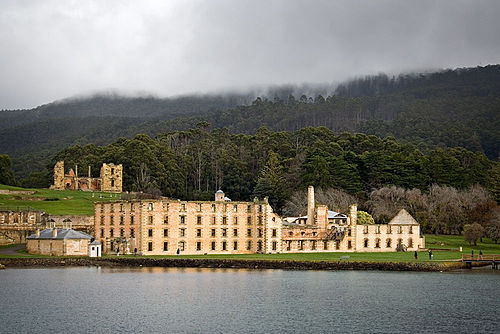Australian Convict Sites
"Australian Convict Sites" is a World Heritage Site which includes the remains of 11 places used in the transportation of convicts to Australia. This was a plan by the British government to move thousands of prisoners from England to Australia. It started with the sending of the First Fleet to Sydney in 1788 and continued for about eighty years. The Australian Convict Sites include places in Sydney, Tasmania, Norfolk Island, and Fremantle. These show:[1]
| UNESCO World Heritage Site | |
|---|---|
 View of Port Arthur, Tasmania one of the 11 penal sites constituting the Australian Convict Sites | |
| Location | Australia |
| Criteria | Cultural: (iv), (vi) |
| Reference | 1306 |
| Inscription | 2010 (34th Session) |
| Area | 1,502.51 ha (3,712.8 acres) |
| Buffer zone | 3,746.68 ha (9,258.2 acres) |
| Coordinates | 33°22′42″S 150°59′40″E / 33.37833°S 150.99444°ECoordinates: 33°22′42″S 150°59′40″E / 33.37833°S 150.99444°E |
" .. the best surviving examples of large-scale convict transportation and the colonial expansion of European powers through the presence and labour of convicts."
All the sites were all individually included on the Australian National Heritage List before being put on the World Heritage list in 2010.
Penal Sites Included
The 11 penal sites making up the Australian Convict Sites World Heritage listed property are[2][3]
- Cockatoo Island Convict Site (New South Wales) [4]
- Great North Road (New South Wales) [5]
- Hyde Park Barracks (New South Wales) [5]
- Old Government House (New South Wales) [5]
- Kingston and Arthurs Vale Historic Area (Norfolk Island) [5]
- Brickendon and Woolmers Estates (Tasmania) [5][6]
- Cascades Female Factory (Tasmania) [5]
- Coal Mines Historic Site (Tasmania) [5]
- Darlington Probation Station (Tasmania) [7]
- Port Arthur (Tasmania) [8]
- Fremantle Prison (Western Australia) [5]
Criteria for Listing
There are over 3000 convict sites remaining in Australia. The Australian Convict Sites were selected as the best examples of the world's convict era. This met World Heritage Selection Criteria IV & VI:[9]
Criterion IV (i.e. a collection of buildings/architecture etc. showing an important stage in human history):
"an exceptional example of the forced migration of convicts - an important stage of human history"
Criterion VI (i.e. directly associated with events etc. of importance to the whole world):
"an extraordinary example of global ideas and developments associated with the punishment and reform of the criminal elements of humanity during the Age of Enlightenment and the modern era
Related pages
References
- ↑ UNESCO's World Heritage "Australian Convict Sites" webpages Accessed 2 August 2010
- ↑ Chalmers, E & Martin, S (1 August 2010) "World Heritage Committee approves Australian Convict Sites as places of importance" Courier Mail website Archived 3 June 2012 at the Wayback Machine Accessed 2 August 2010
- ↑ Australian Department of Environment, Water, Heritage and Arts "World Heritage: Australian Convict Sites" webpage Accessed 4 August 2010
- ↑ "Cockatoo Island - National Heritage - New South Wales - more information". Archived from the original on 2012-10-08. Retrieved 2012-04-10.
- ↑ 5.0 5.1 5.2 5.3 5.4 5.5 5.6 5.7 "Department of the Environment and Energy". Department of the Environment and Energy.
- ↑ "Woolmers Estate - National Heritage - Tasmania - more information". Archived from the original on 2012-03-21. Retrieved 2012-04-10.
- ↑ "Darlington Probation Station - National Heritage - Tasmania - more information". Archived from the original on 2011-03-13. Retrieved 2012-04-10.
- ↑ "Port Arthur Historic Site - National Heritage - Tasmania - more information". Archived from the original on 2012-03-21. Retrieved 2012-04-10.
- ↑ Australian Department of the Environment, Water, Heritage and the Arts (2008) Australian convict sites: World Heritage Nomination Accessed 5 August 2010
Other websites
- Australian Department of the Environment, Water, Heritage and the Arts (2008) Australian convict sites: World Heritage NominationAccessed 5 August 2010
![]()
